Durham astronomers discover an extended hydroden nebula around a dense gas cloud
An extended nebula - one billion times larger than the distance between the Earth and the Sun - has been uncovered by members of the Centre for Extragalactic Astronomy and Institute for Computational Cosmology next to a damped Lyman-α system (DLA), a dense gas cloud rich of neutral hydrogen and heavy elements. Located at a large cosmological distance, DLAs are believed to trace the reservoir of neutral hydrogen next to galaxies that are assembling a few billion years after the Big Bang. This nebula (shown in the Figure) is one of the largest known to date next to a DLA, and is believed to be a signpost of an extended cosmic structure within which multiple galaxies are assembling. While commonly predicted by cosmological simulations, these structures have been mostly elusive so far. However, equipped with the MUSE instrument of the European Southern Observatory’s Very-Large Telescope, astrophysicists at Durham University are on the lookout for even more examples of these nebulae near DLAs, which can provide new clues onto how galaxies form inside cosmic filaments by converting gas into stars.
Link to the original research paper: http://arxiv.org/abs/1707.07003
Contacts from Durham: Michele Fumagalli Ruari Mackenzie James Trayford Tom Theuns Tom Shanks